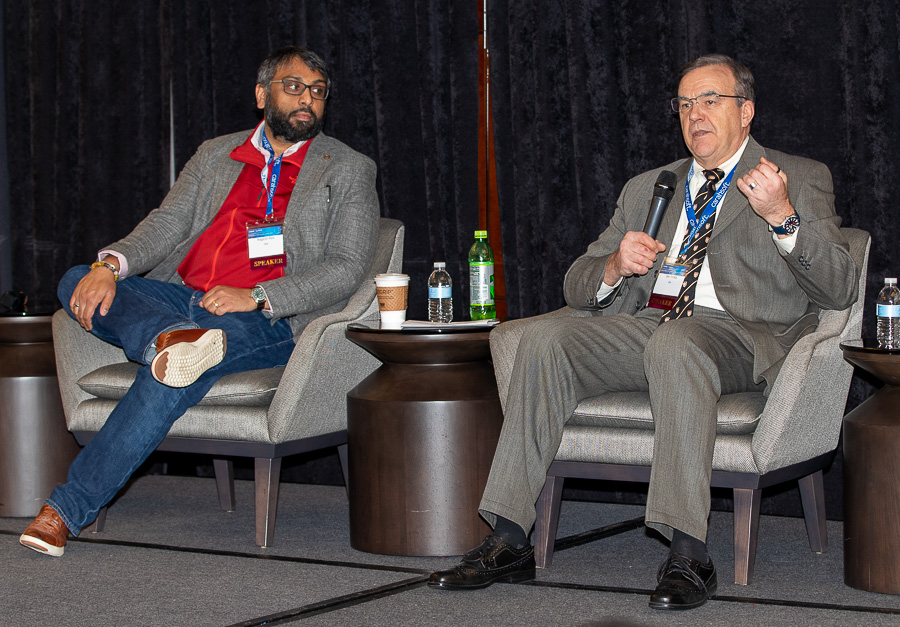
SBA, VA driving the customer to center of IT projects
Nagesh Rao, the director of business technology solutions at the SBA, and Jim Trinka, the chief talent management officer in the Office of Information and Techn...
Best listening experience is on Chrome, Firefox or Safari. Subscribe to Federal Drive’s daily audio interviews on Apple Podcasts or PodcastOne.
The Small Business Administration and the Department of Veterans Affairs are asking their technology employees to step outside their comfort zones.
The two agencies are helping technology employees take a people-first approach to development and services.
Nagesh Rao, the director of business technology solutions at the SBA, said one of his main priorities for 2020 is called CX360, which brings together the customer experience with all parts of SBA.
“How do we ensure when people engage with the agency or our agency partners, that they are getting the right information, the right counseling and the right engagement?” Rao said at the recent Ask the CIO Live panel discussion at the ATARC IT Modernization Summit. “That ties in with our data. I’m trying to integrate it so we have that common base layer of data and information so we can make better decisions as an agency and really use IT as a means of augmentation for our support staff and services.”

SBA reaches 14 million people a year through its website so improving how the programmatic offices can answer questions or how they present information on the web requires a change in thinking and a change in data access.
Rao said the customer relationship management system is trying to ensure there is a business value alignment with technology. It’s part of an omni-channel approach to customer service by using data to connect the dots for the citizens.
Over at VA, Jim Trinka, the chief talent management officer in the Office of Information and Technology, said the agency has had a people-first focus for some time, but getting the IT folks on board is a bigger challenge.
Trinka said this people-first, mission-always mantra has made a huge difference over the last three years around improvements in customer service, federal employee satisfaction and engagement, and most importantly, veterans experience has improved more than 20 percentage points in the last three years.
“In our recruiting and hiring efforts this past year-and-a-half, we started out doing things differently. We focused on our employer brand, which is all about customer collaboration and improving the veterans’ experience with VA,” he said. “In this past year, we’ve hired more new employees than we’ve ever hired before. We actually hired above our authorized strength.”
Trinka said VA is doing new and different processes to bring in the right people. He said that includes resume mining, virtual job fairs and a new collegiate IT recruiting initiative.
“We are bringing in member universities and they are going to give us the curriculum, degrees and certifications that we require and we will do job fairs and recruiting efforts at those member universities,” he said. “We bring them in initially on our employer brand and there is a significant amount of training going on as well.”
No more multiple log-ons
Another way SBA is trying to ease the customer experience is by implementing a single sign-on to its services through the Login.gov service from the General Services Administration.
Rao said the enterprise service is called SBA Connect to get rid of the need for multiple log-ins.
“We want the customer to go through one portal to access the suite of services we provide,” he said. “For the internal feds, we want to have one user name and one password for everything we access. The siloes are killing us.”
Rao said using the one log-in approach, as part of the CX360 program, ensures the SBA knows the small business owner’s history of interaction from start to finish.
“It’s not just the business process, but it’s the culture. One thing I always remind my team is that when you look at entrepreneurs as our customers, they go from digital natives to baby boomers. That age range is so vast amongst the group that each group looks at issues and the use of technology very differently. This notion that it’s a one-size fits all doesn’t work,” he said. “We have to get creative for how we create an a la carte approach to how we deploy our technology solutions and how do we make the business process and the business engagement with our customers, peers in government and various stakeholders such that it’s meaningful and people get what it is they want from the engagement.”
VA also is changing its culture, or as Trinka likes to say, going from the “waiter/waitress” mode of the IT office taking orders to one of collaboration across the mission or business areas.
“We are focusing on an outcome instead of measuring activities. The outcome we are focused on is improving the veteran experience,” he said. “When we build business cases for everything we do, it has to show measurable improvement in the veteran experience. We have our new account management office that does business relationship management with our customers. One of our customers came in and said we have to have this new system because they were sold on it by a vendor. But the account manager asked, ‘how much does it improve the veteran experience?’ It was a realization. That’s how we work with our customers to drive that engagement.”
Copyright © 2024 Federal News Network. All rights reserved. This website is not intended for users located within the European Economic Area.
Jason Miller is executive editor of Federal News Network and directs news coverage on the people, policy and programs of the federal government.
Follow @jmillerWFED
Related Stories






